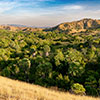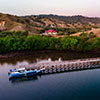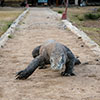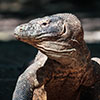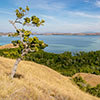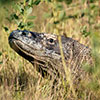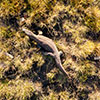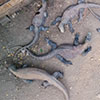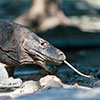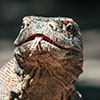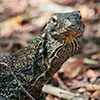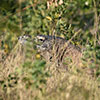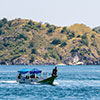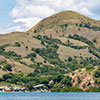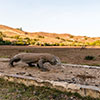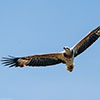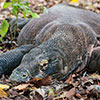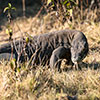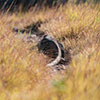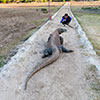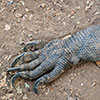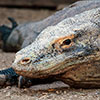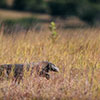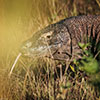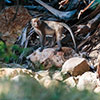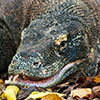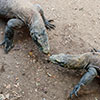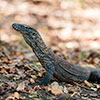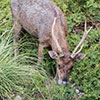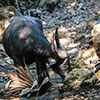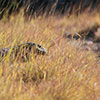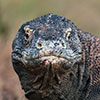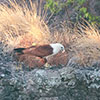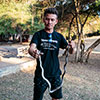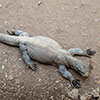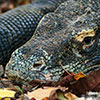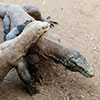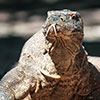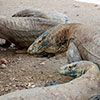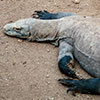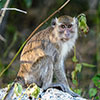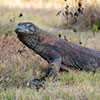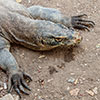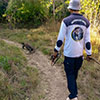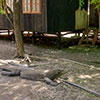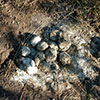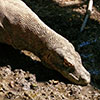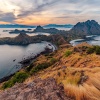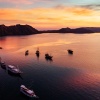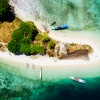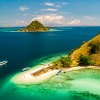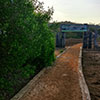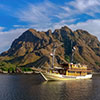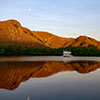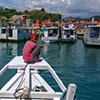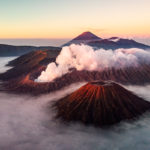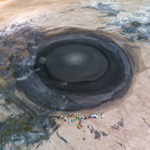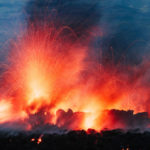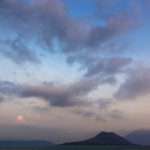Meeting the Saurians – The Dragons of Komodo
In the middle of the island kingdom of Indonesia, a prehistoric lizard species has survived that literally eclipses all other species: the giant Komodo Dragon. The Komodo dragon can be up to 3 meters long and 70 kg heavy. On the Island of Rinca it is easiest to observe the dragons, and I was even allowed to use the drone.
Sea journey to the Dragons
Correct, not on the Island of Komodo but on Rinca (spoken Rincha) chances are best to see the animals. And that’s exactly where my journey goes to. I visited West Flores already 10 years ago, when I returned from capturing the coloured crater lakes of the Kelimutu volcano and wanted to fly out via Labuan Bajo. Today, the newly erected glass-steel terminal building no longer reminds of the former village airfield back in 2009. The large Komodo dragon statue is the only thing remaining.
At that time, I had to go to the office of Merpati airline to buy a ticket. Today, all this can be done conveniently via apps, on my mobile phone. Back then I noticed the beautiful harbour with its army of local fisher boats. Even today Labuan Bajo is primarily a harbour town, but its appearance has changed enormously. It is still the number one port to embark on trips to coastal islands like Komodo and Rinca.
I am looking at 2-3 boats being in good condition. Negotiate with the crews a little, and then we can already set the sails after short food and water shopping. Well, life jackets are important! The currents between the islands are treacherous and there are quite a few accidents in which divers and swimmers have been dragged into the depths. The choppy sea gives information about such dangerous spots. I would like to travel for four days; to the Island of Rinca to visit the Komodo dragons as well as see sunrise and sunset from Padar Island.
In close contact with primeval times
Late afternoon we reach Rinca Island, or more precisely the landing site of Loh Buaya. First I go to the ranger office to discuss and organise everything for the next 2 days in advance. If at all, then then the animals are active only in the morning. And since the sun singes the whole day, I want to make the most out of the morning hours. The national park on Rinca Island offers different hiking trails. Staying outside and away from those paths is forbidden and also not possible, as one’s only allowed to hike having a ranger at your side all the time.
On the way to the village – the villagers are (interestingly) all rangers – I already see the first Komodo dragon waiting for waste under the window of the kitchen. Well, those creatures are not stupid… One definitely doesn’t want to be bitten, because besides very pointy and sharp teeth, the animal is in particular known for its toxic saliva. Its hunting strategy is to pretend disinterest and letting the victim come within striking distance. Once the victim is bitten, it perishes at the toxic saliva cocktail. Then the Komodo dragon has all the time in the world to track down its victim.
Hiking around Rinca Island we meet the main prey of the Komodo dragon, i.e. big creatures like water buffalos or deer. From time to time, there is even a monkey on the menu if it was too incautious. The dragon may appear being disinterested, but it can mobilise all its powers in a flash when a victim is within striking distance.
Komodo dragons perceive and recognise their environment primarily through their scenting ability, that is part of their tongue. Hence the whole terrain and all of its (living) parts they “see” by darting the tongue in and out. The animal also has eyes of course, but something that’s playing a minor role are its ears. At least according to human definition, because the (permitted!) use of my drone did not even have the merest influence on the animal. Komodo dragons are very well camouflaged and therefore difficult to spot in the terrain.
Observation from the air
In the evening and morning hours a young animal as well as a full-grown dragon dared to leave the thicket. That’s when I could use the drone. Then good photo results depend more on good flying skills than on photography. All things called dragon become only busy during the mating season, when the big males fight for the favour of the females. Well, and since there is no mating season, the dragons lie motionless like a stone in the forest, grass or thicket. That’s fair enough for a few proper animal portraits and close-ups but from a photographer point of view that’s a bit boring though, because of missing display of animal behaviour.
Hence I concentrate on working with the drone before the boat journey continues to Padar Island. Before we had to scare off a nightly “attack” of cheeky monkey gang. Those littles beasts know pretty well that there are a lot of interesting things on the boats. So they sneak over the jetty onto the water vehicle trying to steel. Fortunately we noticed that, otherwise everything, literally everything lying around would be a potential monkey sacrifice.
It’s very interesting to see not a few Komodo dragons living in the middle of a local village. Obviously those animals have found a constant source of food, therefore they settled. It might be quite interesting for the villagers to walk to the toilet at night among the dragons… For my part, I am more of an exotic visitor, because I stay longer than 1-2 hours only. Hence I gladly accept the evening beer invitation, also feel out what ranger everyday life means over here.

